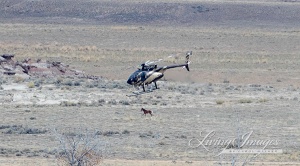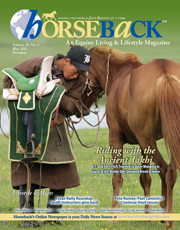by as published on High Country News
Species extinction, near-constant wildfire and widespread drought are a few dangers William Perry Pendley might consider instead

Last week’s BLM attack upon the Fifteenmile herd in Wyoming. Photo by Carol Walker of Wild Horse Freedom Federation.
In mid-October, William Perry Pendley, the acting director of the Bureau of Land Management, warned environmental journalists at a conference in Fort Collins, Colorado, about the greatest problem facing the 244 million acres of public land that he is charged with overseeing. This scourge “wreaks havoc” everywhere it goes, and — far more than a mere headache for land managers — it is an “existential threat” to the lands that Americans hold dear. And that threat is? Wait for it … wild horses.
The statement was so over the top, so ignorant of the actual threats to the planet, that one almost expected Pendley to pull out a Sharpie, a la President Donald Trump, and scribble on a map showing the projected storm path of a vast herd of feral equines, before revealing that the whole scene was the opening skit for Saturday Night Live. But Pendley wasn’t joking. Whether he believed what he said, or was just throwing it out there to distract folks from the real threats — namely, his and his bosses’ environmental agenda — remains unknown.
Horses — whether wild, feral or domesticated — can, indeed, make a mess of things. An estimated 88,000 wild horses and burros currently roam federal public lands. Each of them weighs, on average, 850 pounds, and eats as much as 25 pounds of grasses and forage per day. Their hooves trample and lay waste to big swaths of cryptobiotic soil, the living crust that keeps much of the Western landscape from dissolving into a cloud of dust. These animals do not tread lightly.
So, yes, wild horses do, indeed, cause damage. Pendley’s not wrong about that. It’s his use of superlatives, his claim that wild horses are the biggest problem facing public lands — even an existential threat — that stretches the bounds of logic.
According to Pendley’s own reasoning, for example, cattle should be a much greater menace. The average beef cow, according to Beef magazine, weighs 500 pounds more than a wild horse, meaning its hooves will cut that much deeper into the delicate soil. Each of these walking hamburger factories eats more, poops more, and tramples vegetation more thoroughly than a wild horse. Plus, there are a heck of a lot more of them: Last year, close to 2 million head of cattle feasted upon BLM lands, with another couple million on Forest Service land.
Pendley said that horses leave land “so devastated and destroyed” that it will never recover. The same can be said of oil and gas companies. For each of the 23,000 wells drilled on public land over the past decade, more than an acre of land was scraped clean of all vegetation, top soil, cactuses, sagebrush and even centuries-old juniper trees. The hulking drill rigs then came in and churned miles into the earth, followed by fracking trucks, which blasted water, chemicals and sand into the hole. For weeks or even months afterward, tons of methane — a potent greenhouse gas — along with harmful volatile organic compounds were flared or vented from the wells. Oil or wastewater spills are not uncommon.
And yet Pendley doesn’t seem to see grazing, oil and gas, or any other extractive industry as a potential problem for public lands. Nor has he expressed concern about global warming-driven wildfires that rage almost year-round, about the potential extinction of the sage grouse or the widespread drought that even one of the wettest winters on record couldn’t end. And Pendley completely ignored the impacts of the burgeoning numbers of human beings now flocking to public lands for recreation.
Instead, Pendley is fixated on wild horses, in a clear attempt to distract Westerners from his larger purpose. Prior to becoming a federal bureaucrat, Pendley was the president of the Mountain States Legal Foundation. Under his leadership, that organization fought in court to overturn a ban on uranium mining near the Grand Canyon, it represented oil and gas interests fighting for their “property rights” to drill on public land, it fought the Northern Arapahoe and Eastern Shoshone tribes’ ability to administer the Clean Air Act on land taken from them in 1905, and it attempted to overthrow protections for endangered species. Pendley has spent much of his life waging an ideological crusade intent on wrecking the very agency that he now oversees.
Pendley claims that his own past is irrelevant, and that these days he is merely following orders. If that’s true, it’s only because his superiors’ aims align so closely with his. The Trump administration has systematically weakened its own government agencies, torn down environmental protections, attacked tribal sovereignty, and done everything it can to turn public lands into profit-making machines for corporate interests.
The real problem with wild horses is that there’s no money to be made from them. And by focusing on them, Pendley hopes to divert our attention from the true threat to public lands: unbridled greed.
Jonathan Thompson is a contributing editor at High Country News. He is the author of River of Lost Souls: The Science, Politics and Greed Behind the Gold King Mine Disaster. Email him at jonathan@hcn.org or submit a letter to the editor.









These demons with human faces need to be stripped of all their power and sent to prison. The wild lands must be restored and the horses and burros released back to the range.
LikeLiked by 1 person
Timely article but contains a few biological omissions. Since horses evolved on this continent, in these ecosystems, they are much better suited to them than any introduced livestock could be. Yes, if contained in ever-shrinking areas not of their choosing, with their natural predators routinely killed off to protect livestock, you will see impacts. These are countered by what benefits they also bring: reseeding native vegetation, generally spreading those hoofprints dozens of miles per day if allowed (rather than concentrating and loitering), and in the case of burros, excavating water holes that dozens of other species can and do use.
It’s also a stretch to lay all blame for range conditions on wildlife when we have a few hundred years of abject commercial abuse of these lands through human endeavors, from which these fragile ecosystems are still adapting. Sprinkle in some long droughts and dropping water tables as well and it’s clear we have a systemic problem which a single species can be fingered, and it isn’t wild horses.
LikeLike
There doesn’t look to be place for comments on the article but it is possible to write a letter to the editor or contact the author. We do need keep establishing that WH&B are NOT overpopulated. Congress and the Public need to know the truth
Jonathan Thompson is a contributing editor at High Country News. He is the author of River of Lost Souls: The Science, Politics and Greed Behind the Gold King Mine Disaster. Email him at jonathan@hcn.org or submit a letter to the editor.
https://www.hcn.org/feedback/contact-us
LikeLike
The author did hit the nail squarely on the head in this one sentence
“The real problem with wild horses is that there’s no money to be made from them. And by focusing on them, Pendley hopes to divert our attention from the true threat to public lands: unbridled greed.”
LikeLike
I wrote this author and pointed out his comment has not been proven, in that nobody has measured the economic input of just wild horse and burro activities, nor has the obvious channel of enabling interested people to buy habitat stamps or similar for them ever been tried (to my knowledge). Stamps are a proven means to support other wildlife very well, as are hunting licenses, but why can’t we buy a stamp each year to support every individual HMA (without killing) as well as an overall stamp to support the entire remaining population in ten western states + our east coast herds? People from all states and countries could buy these to show support, but these options don’t exist today.
Nobody has tried this, so the assumption is no money can be made. I say, game on, let’s try for ten years and find out!
LikeLike
From AWHC
William Perry Pendley, the Acting Director of the Bureau of Land Management (BLM) announced this week that it would cost the taxpayers $5,000,000,000.00 to clear public lands of wild horses.
Pendley knows exactly what he’s doing. By putting an outrageously high price tag on humane management of wild horses and burros, he’s laying the groundwork to make the case that non-lethal management of wild horses is too expensive and that slaughter is the only option.
Just last week, Pendley labeled wild horses an “existential threat” to public lands in America, even though wild horses aren’t even present on 88% of BLM lands.
Pendley’s goal is to divert attention away from the commercial industries, including livestock grazing, that are the true “existential” threats to public lands, while simultaneously securing funding from Congress for unprecedented mass wild horse and burro roundups.
Pendley is executing a sophisticated propaganda campaign against wild horses. Phase 1 was to establish a fake crisis of wild horse overpopulation. That has largely been achieved with the HSUS, ASPCA and Return to Freedom capitulation to the livestock industry agenda of reducing wild horse and burro populations to near extinction levels.
Phase 2, to convince Congress that non-lethal management of wild horses is too expensive, is now underway.
LikeLiked by 1 person
Sent to me today … and this explains a LOT!
Under the current political regime, BLM has to show itself favoring the Sagebrush Seditionists — Trump’s base. BLM’s Acting Director is working to re-elect Trump. So, the Agency must appear as if it is on the side of the land-grabbers.
The massive roundups, appear to be show-removals to con the cattlemen into believing that all those horses that, the ranchers complain, are eating their grass are being removed by the thousands. This con also sends the message that it isn’t the millions of cattle that are ruining the range but those “overpopulated” wild horses. This placates the cattlemen and makes them feel vindicated. Surely, they will then vote for Trump, and other Red State voters who sympathize with the “poor” cattlemen will too.
LikeLike
Drill down deeper and Follow the Money
Land transfer advocate and longtime agency combatant now leads BLM
Chris D’Angelo Aug. 8, 2019
“This is Sagebrush Rebellion 2020,” one current BLM employee in the West told HuffPost, adding that it is “hard to imagine” Pendley’s appointment isn’t a move toward eventually selling off federal lands or transferring control to the states.
“All the news about the BLM is really depressing and fits with this administration that is trying to destroy everything in the name of profits as we face serious economic and environmental catastrophe,” the BLM employee, who requested anonymity for fear of retribution, told HuffPost in a text message. “I try not to think about it too much.”
In November 2018, Interior hosted at its D.C. headquarters members of the right-wing American Legislative Exchange Council, the Koch brothers-backed nonprofit pushing for the federal government to hand over control of its lands to states.
In November 2018, Interior hosted at its D.C. headquarters members of the right-wing American Legislative Exchange Council,
the Koch brothers-backed nonprofit pushing for the federal government to hand over control of its lands to states. At the closed-door event, Zinke apparently stood his ground on sale and transfer, but voiced support for entering into agreements with states to give them a greater say in how public lands are managed, according to posts by South Carolina state Rep. Alan Clemmons (R), the secretary of ALEC’s board of directors.
“So much progress is coming from the work and leadership of Secretary Zinke,” Utah state Rep. Ken Ivory (R), the former head of the Free the Lands project, wrote in a Facebook post, along with photos of him posing with Zinke and other agency officials.
https://www.hcn.org/articles/climate-desk-bureau-of-land-management-land-transfer-advocate-and-longtime-agency-combatant-now-leads-blm
LikeLike